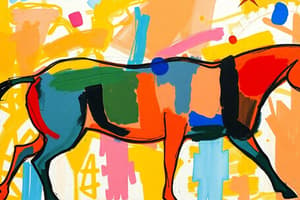Podcast
Questions and Answers
Which of the following is an example of a descriptive adjective indicating color?
Which of the following is an example of a descriptive adjective indicating color?
- red (correct)
- round
- happy
- tall
Descriptive adjectives can only be used before the noun they modify.
Descriptive adjectives can only be used before the noun they modify.
False (B)
What is a comparative form of the adjective 'tall'?
What is a comparative form of the adjective 'tall'?
taller
She has a ______ garden.
She has a ______ garden.
Which of these adjectives is used to describe a physical characteristic?
Which of these adjectives is used to describe a physical characteristic?
What term is used for the superlative form of 'beautiful'?
What term is used for the superlative form of 'beautiful'?
Match the adjectives with their types:
Match the adjectives with their types:
The house is ______.
The house is ______.
Flashcards are hidden until you start studying
Study Notes
Adjetivos Descriptivos en Inglés
-
Definición:
- Los adjetivos descriptivos son palabras que califican o caracterizan a un sustantivo, proporcionando información sobre características, cualidades o estados.
-
Función:
- Describir propiedades (color, tamaño, forma, etc.)
- Indicar estados emocionales o físicos.
- Proporcionar información sobre la cantidad o número.
-
Tipos de Adjetivos Descriptivos:
- Color: red (rojo), blue (azul), green (verde).
- Tamaño: big (grande), small (pequeño), tiny (minúsculo).
- Forma: round (redondo), square (cuadrado), flat (plano).
- Textura: smooth (suave), rough (áspero), soft (blando).
- Estado emocional: happy (feliz), sad (triste), excited (emocionado).
-
Uso:
- Se colocan generalmente antes del sustantivo:
- e.g. "a big house" (una casa grande).
- Pueden usarse después de verbos como "to be":
- e.g. "The house is big" (La casa es grande).
- Se colocan generalmente antes del sustantivo:
-
Comparativos y Superlativos:
- Comparativos: se forman añadiendo "-er" o usando "more".
- e.g. "taller" (más alto), "more beautiful" (más hermoso).
- Superlativos: se forman añadiendo "-est" o usando "most".
- e.g. "tallest" (el más alto), "most beautiful" (el más hermoso).
- Comparativos: se forman añadiendo "-er" o usando "more".
-
Ejemplos Comunes:
- Descripciones físicas: tall (alto), short (bajo), heavy (pesado).
- Descripciones de personalidad: friendly (amigable), shy (tímido), brave (valiente).
-
Reglas Especiales:
- Adjetivos de una sílaba generalmente llevan "-er" en el comparativo y "-est" en el superlativo.
- Adjetivos de dos sílabas que terminan en -y también siguen esta regla.
- Adjetivos de más de dos sílabas usan "more" y "most" para comparativos y superlativos.
-
Uso en Oraciones:
- "She has a beautiful garden."
- "This is the fastest car in the race."
Recuerda que el uso correcto de los adjetivos puede enriquecer el lenguaje y mejorar la claridad en la comunicación.
Descriptive Adjectives in English
- Descriptive adjectives qualify or characterize nouns, offering insights into characteristics, qualities, or states.
Functions of Descriptive Adjectives
- Describe properties such as color, size, and shape.
- Indicate emotional or physical states.
- Provide information regarding quantity or numbers.
Types of Descriptive Adjectives
- Color: Examples include red, blue, and green.
- Size: Examples are big, small, and tiny.
- Shape: Common terms include round, square, and flat.
- Texture: Includes smooth, rough, and soft.
- Emotional State: Examples are happy, sad, and excited.
Placement of Adjectives
- Typically placed before the noun (e.g., "a big house").
- Can also follow verbs like "to be" (e.g., "The house is big").
Comparative and Superlative Forms
- Comparatives: Created by adding "-er" or using "more" (e.g., "taller," "more beautiful").
- Superlatives: Formed by adding "-est" or using "most" (e.g., "tallest," "most beautiful").
Common Examples
- Physical Descriptions: tall, short, heavy.
- Personality Traits: friendly, shy, brave.
Special Rules
- One-syllable adjectives typically take "-er" for comparatives and "-est" for superlatives.
- Two-syllable adjectives ending in -y also follow this pattern.
- Adjectives with more than two syllables use "more" and "most" for comparatives and superlatives.
Usage in Sentences
-
Examples include "She has a beautiful garden." and "This is the fastest car in the race."
-
Correct usage of adjectives enhances language richness and clarity in communication.
Studying That Suits You
Use AI to generate personalized quizzes and flashcards to suit your learning preferences.




